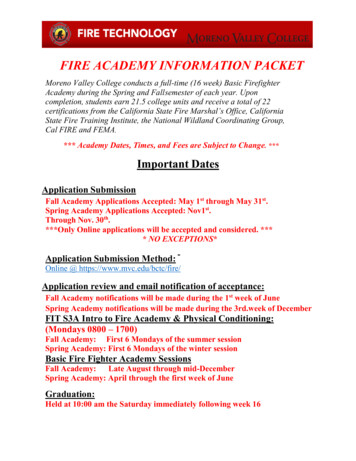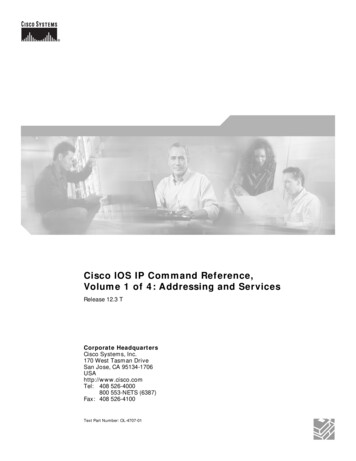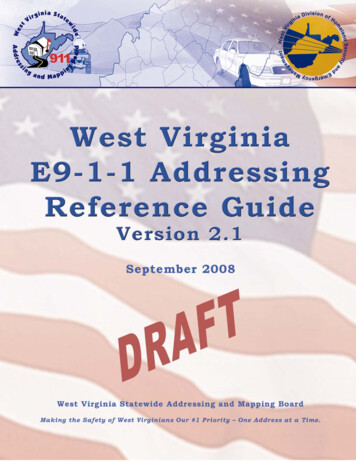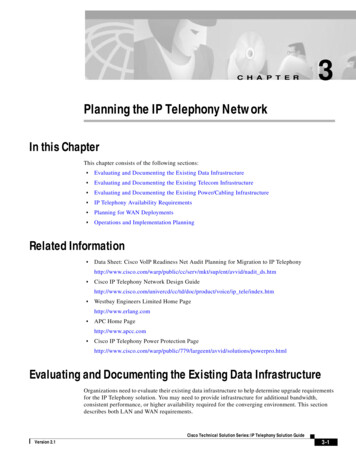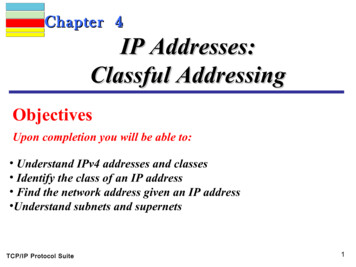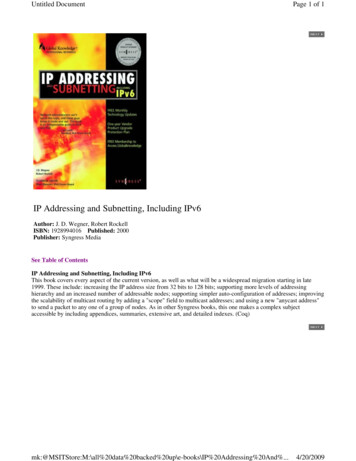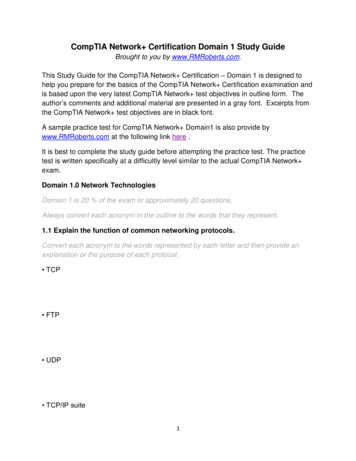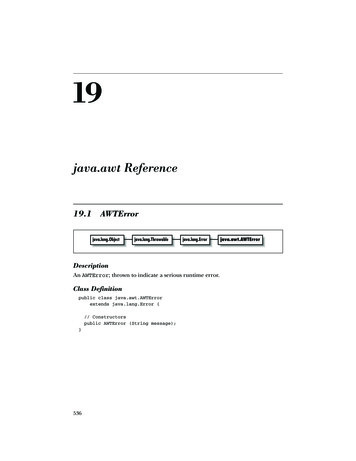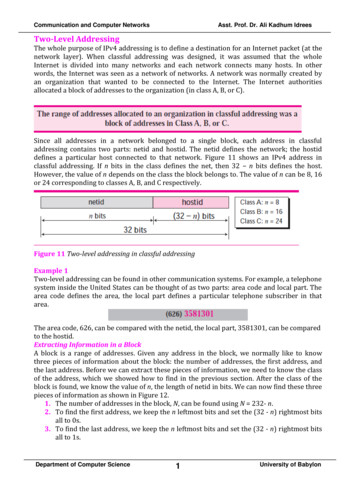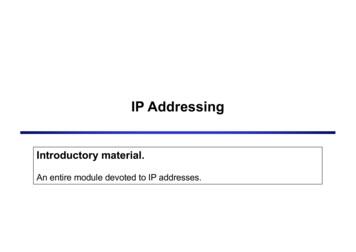
Transcription
IP AddressingIntroductory material.An entire module devoted to IP addresses.
IP Addresses Structure of an IP addressClassful IP addressesLimitations and problems with classful IP addressesSubnettingCIDRIP Version 6 addresses
IP Addresses32 bitsversion(4 bits)headerlengthType of Service/TOS(8 bits)flags(3 bits)Identification (16 bits)TTL Time-to-Live(8 bits)Total Length (in bytes)(16 bits)Protocol(8 bits)Fragment Offset (13 bits)Header Checksum (16 bits)Source IP address (32 bits)Destination IP address (32 bits)Ethernet HeaderIP HeaderTCP HeaderEthernet frameApplication dataEthernet Trailer
IP Addresses32 bits0x40x50x009d08128 1044 10010 20000000000000 20x068bff128.143.137.144128.143.71.21Ethernet HeaderIP HeaderTCP HeaderEthernet frameApplication dataEthernet Trailer
What is an IP Address? An IP address is a unique global address for a networkinterface An IP address:- is a 32 bit long identifier- encodes a network number (network prefix)and a host number
Dotted Decimal Notation IP addresses are written in a so-called dotted decimalnotation Each byte is identified by a decimal number in the range[0.255]: Example:100000001st Byte 128100011112nd Byte 143100010013rd Byte 137128.143.137.144100100004th Byte 144
Network prefix and Host number The network prefix identifies a network and the host numberidentifies a specific host (actually, interface on the network).network prefixhost number How do we know how long the network prefix is?– The network prefix is implicitly defined (see class-basedaddressing)– The network prefix is indicated by a netmask.
Example Example: ellington.cs.virginia.edu128.143137.144 Network id is: Host number is: Network mask is:128.143.0.0137.144255.255.0.0 Prefix notation:128.143.137.144/16» Network prefix is 16 bits longor ffff0000
The old way: Classful IP Adresses When Internet addresses were standardized (early 1980s),the Internet address space was divided up into classes:– Class A: Network prefix is 8 bits long– Class B: Network prefix is 16 bits long– Class C: Network prefix is 24 bits long Each IP address contained a key which identifies the class:– Class A: IP address starts with “0”– Class B: IP address starts with “10”– Class C: IP address starts with “110”
The old way: Internet Address Classesbit # 0Class A17 8310Network PrefixHost Number8 bits24 bitsbit # 0 1 2Class B1015 16network id110hostNetwork PrefixHost Number16 bits16 bitsbit # 0 1 2 3Class C3123 24network id31hostNetwork PrefixHost Number24 bits8 bits
The old way: Internet Address Classesbit # 0 1 2 3 4Class D111031multicast group idbit # 0 1 2 3 4 5Class E1111031(reserved for future use) We will learn about multicast addresses later in this course.
Problems with Classful IP Addresses The original classful address scheme had a numberof problemsProblem 1. Too few network addresses for largenetworks– Class A and Class B addresses are goneProblem 2. Two-layer hierarchy is not appropriatefor large networks with Class A and Class Baddresses.– Fix #1: Subnetting
Problems with Classful IP AddressesProblem 3. Inflexible. Assume a company requires 2,000addresses– Class A and B addresses are overkill– Class C address is insufficient (requires 8 Class Caddresses)– Fix #2: Classless Interdomain Routing (CIDR)
Problems with Classful IP AddressesProblem 4: Exploding Routing Tables: Routing on thebackbone Internet needs to have an entry for each networkaddress. In 1993, the size of the routing tables started tooutgrow the capacity of routers.– Fix #2: Classless Interdomain Routing (CIDR)
Problems with Classful IP AddressesProblem 5. The Internet is going to outgrow the 32bit addresses– Fix #3: IP Version 6
Subnetting Problem: Organizationshave multiple networkswhich are independentlymanaged– Solution 1: Allocate one ormore Class C address foreach network Difficult to manage From the outside of theorganization, each networkmust be addressable.University NetworkEngineeringSchoolMedicalSchoolLibrary– Solution 2: Add anotherlevel of hierarchy to theIP addressing structureSubnetting
Basic Idea of Subnetting Split the host number portion of an IP address into asubnet number and a (smaller) host number. Result is a 3-layer hierarchynetwork prefixnetwork prefix Then:host numbersubnet numberhost numberextended network prefix Subnets can be freely assigned within the organization Internally, subnets are treated as separate networks Subnet structure is not visible outside the organization
Subnet Masks Routers and hosts use an extended network prefix (subnetmask) to identify the start of the host numbersClass B10networkhost16 bitsNetwork Prefix (16 tended Network Prefix (24 )* There are different ways of subnetting. Commonly used netmasks for universitynetworks with /16 prefix (Class B) are 255.255.255.0 and 255.255.0.0
Typical Addressing Plan for an Organization thatuses subnetting Each layer-2 network (Ethernet segment, FDDI segment) isallocated a subnet address.128.143.71.0 / 24128.143.0.0/16128.143.7.0 / 24128.143.16.0 / 24128.143.8.0 / 24128.143.17.0 / 24128.143.22.0 / 24128.143.136.0 / 24
Advantages of Subnetting With subnetting, IP addresses use a 3-layer hierarchy:» Network» Subnet» Host Improves efficiency of IP addresses by not consuming anentire Class B or Class C address for each physical network/ Reduces router complexity. Since external routers do notknow about subnetting, the complexity of routing tables atexternal routers is reduced. Note: Length of the subnet mask need not be identical at allsubnetworks.
CIDR - Classless Interdomain Routing IP backbone routers have one routing table entry for eachnetwork address:– With subnetting, a backbone router only needs to know one entry foreach Class A, B, or C networks– This is acceptable for Class A and Class B networks 27 128 Class A networks 214 16,384 Class B networks– But this is not acceptable for Class C networks 221 2,097,152 Class C networks In 1993, the size of the routing tables started to outgrow thecapacity of routers Consequence: The Class-based assignment of IP addresseshad to be abandoned
CIDR - Classless Interdomain Routing Goals:– Restructure IP address assignments to increase efficiency– Hierarchical routing aggregation to minimize route tableentries CIDR (Classless Interdomain routing) abandons the notion ofclasses:Key Concept: The length of the network id (prefix) in the IPaddresses is kept arbitrary Consequence: Routers advertise the IP address and thelength of the prefix
CIDR Example CIDR notation of a network address:192.0.2.0/18 "18" says that the first 18 bits are the network part of theaddress (and 14 bits are available for specific hostaddresses) The network part is called the prefix Assume that a site requires a network address with 1000 addresses With CIDR, the network is assigned a continuous block of 1024 addresseswith a 22-bit long prefix
CIDR: Prefix Size vs. Network SizeCIDR Block 3# of Host Addresses32 hosts64 hosts128 hosts256 hosts512 hosts1,024 hosts2,048 hosts4,096 hosts8,192 hosts16,384 hosts32,768 hosts65,536 hosts131,072 hosts262,144 hosts524,288 hosts
CIDR and Address assignments Backbone ISPs obtain large block of IP addresses space andthen reallocate portions of their address blocks to theircustomers.Example: Assume that an ISP owns the address block 206.0.64.0/18, whichrepresents 16,384 (214) IP addresses Suppose a client requires 800 host addresses With classful addresses: need to assign a class B address (andwaste 64,700 addresses) or four individual Class Cs (and introducing 4new routes into the global Internet routing tables) With CIDR: Assign a /22 block, e.g., 206.0.68.0/22, and allocated ablock of 1,024 (210) IP addresses.
CIDR and Routing InformationCompany X :ISP X .188.0.0/15209.88.232.0/21ISP y :209.88.237.0/24Organization z1 :Organization z2 :209.88.237.192/26209.88.237.0/26
CIDR and Routing InformationBackbone routers do not knowanything about Company X, ISPY, or Organizations z1, z2.Company X :ISP X does not know aboutOrganizations z1, z2.InternetISP X sends everything whichBackbonematches the prefix:206.0.68.0/22ISPISPy sendseverything which matchesX owns:the prefix:206.0.64.0/18209.88.237.192/26 to Organizations z1204.188.0.0/15209.88.237.0/26 to Organizations z2209.88.232.0/21ISP y :206.0.68.0/22 to Company X,209.88.237.0/24 to ISP yBackbone sends everythingwhich matches the prefixes206.0.64.0/18, 204.188.0.0/15,209.88.232.0/21 to ISP X.209.88.237.0/24Organization z1 :Organization z2 :209.88.237.192/26209.88.237.0/26
You can find about ownership of IP addresses inNorth America via http://www.arin.net/whois/Example The IP Address:207207.2.88.17028817011001111 00000010 01011000 10101010Belongs to:City of Charlottesville, VA: 207.2.88.0 - 207.2.92.25511001111 00000010 01011000 00000000Belongs to:Cable & Wireless USA 207.0.0.0 - 207.3.255.25511001111 00000000 00000000 00000000
CIDR and Routing Aggregation of routing table entries:– 128.143.0.0/16 and 128.144.0.0/16 are represented as128.142.0.0/15 Longest prefix match: Routing table lookup finds therouting entry that matches the the longest prefixWhat is the outgoing interface for128.143.137.0/24 ?PrefixInterface128.0.0.0/4interface #5128.128.0.0/9interface #2128.143.128.0/17 interface #1Routing table
IPv6 - IP Version 6 IP Version 6– Is the successor to the currently used IPv4– Specification completed in 1994– Makes improvements to IPv4 (no revolutionary changes) One (not the only !) feature of IPv6 is a significant increase inof the IP address to 128 bits (16 bytes) IPv6 will solve – for the foreseeable future – theproblems with IP addressing
IPv6 Header32 bitsversion(4 bits)Traffic Class(8 bits)Payload Length (16 bits)Flow Label(24 bits)Next Header(8 bits)Hop Limits (8 bits)Source IP address (128 bits)Destination IP address (128 bits)Ethernet HeaderIPv6 HeaderTCP HeaderEthernet frameApplication dataEthernet Trailer
IPv6 vs. IPv4: Address Comparison IPv4 has a maximum of232 » 4 billion addresses IPv6 has a maximum of2128 (232)4 » 4 billion x 4 billion x 4 billion x 4 billionaddresses
Notation of IPv6 addresses Convention: The 128-bit IPv6 address is written as eight 16bit integers (using hexadecimal digits for each integer)CEDF:BP76:3245:4464:FACE:2E50:3025:DF12 Short notation: Abbreviations of leading zeroes:CEDF:BP76:0000:0000:009E:0000:3025:DF12à CEDF:BP76:0:0:9E :0:3025:DF12 “:0000:0000:0000” can be written as “::”CEDF:BP76:0:0:FACE:0:3025:DF12à CEDF:BP76::FACE:0:3025:DF12 IPv6 addresses derived from IPv4 addresses have 96 leading zero bits.Convention allows to use IPv4 notation for the last 32 bits.::80:8F:89:90 à ::128.143.137.144
IPv6 Provider-Based Addresses The first IPv6 addresses will be allocated to a provider-basedplanRegistry Provider Subscriber Subnetwork Interface010IDIDIDIDID Type: Set to “010” for provider-based addresses Registry: identifies the agency that registered the addressThe following fields have a variable length (recommeded length in “()”) Provider: Id of Internet access provider (16 bits)Subscriber: Id of the organization at provider (24 bits)Subnetwork: Id of subnet within organization (32 bits)Interface: identifies an interface at a node (48 bits)
More on IPv6 Addresses The provider-based addresses have a similar flavor as CIDRaddresses IPv6 provides address formats for:– Unicast – identifies a single interface– Multicast – identifies a group. Datagrams sent to amulticast address are sent to all members of the group– Anycast – identifies a group. Datagrams sent to an anycastaddress are sent to one of the members in the group.
Problems with Classful IP Addresses The original classful address scheme had a number of problems Problem 1.Too few network addresses for large networks -Class A and Class B addresses are gone Problem 2.Two-layer hierarchy is not appropriate for large networks with Class A and Class B addresses. -Fix #1:Subnetting

